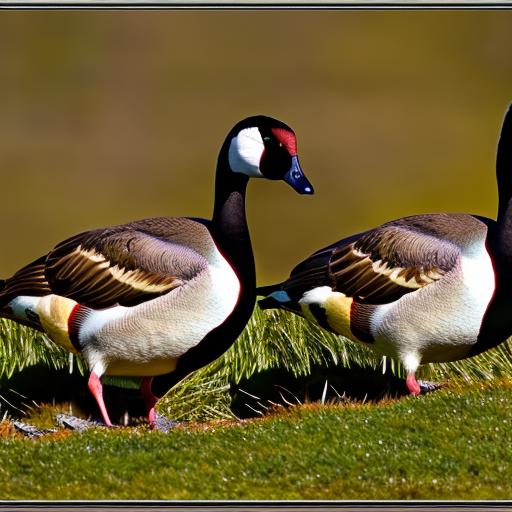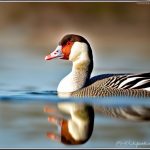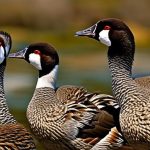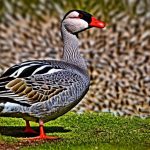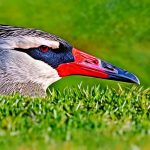Canada geese are a common sight in many parts of North America, known for their distinctive honking and V-shaped flight formations. These large birds are known for their adaptability and can be found in a variety of habitats, including parks, lakes, and even urban areas. However, one common problem that many homeowners face is the presence of Canada geese flocking to their lawns. These birds can cause damage to lawns by eating grass and leaving behind droppings, which can be unsightly and difficult to clean up.
Key Takeaways
- Canada geese are social birds that mate for life and are highly protective of their young.
- Canada geese are attracted to lawns because they provide easy access to food, water, and shelter.
- Physical barriers such as fences, hedges, and netting can be effective in deterring Canada geese.
- Decoys that resemble predators or other birds can help keep Canada geese away from your lawn.
- Repellents such as taste aversions and visual deterrents can discourage Canada geese from staying on your lawn.
Understanding the behavior of Canada geese
To effectively deter Canada geese from your lawn, it is important to understand their behavior and habits. Canada geese are social birds that typically travel in flocks or family groups. They are attracted to open areas with short grass, such as lawns, because it provides easy access to food and a clear line of sight to potential predators.
Canada geese are herbivores and primarily feed on grass, but they will also eat other vegetation such as clover and dandelions. They have a keen sense of sight and can spot potential food sources from a distance. Once they find a suitable area, they will often return to it repeatedly.
Identifying the reasons why Canada geese flock to your lawn
There are several reasons why Canada geese are attracted to lawns. Firstly, lawns provide an abundant source of food in the form of grass. The short grass found on lawns is easy for the geese to graze on and provides them with the nutrients they need.
Secondly, lawns offer open spaces with good visibility, allowing the geese to keep an eye out for predators while they feed. This makes lawns an attractive location for them to gather and rest.
Lastly, lawns often provide access to water sources such as ponds or lakes, which are essential for the geese to drink and bathe. If your lawn is located near a water source, it is more likely to attract Canada geese.
To identify if your lawn is a target for Canada geese, look for signs such as large groups of geese congregating on your lawn, droppings scattered across the grass, and patches of grass that have been grazed down to the roots.
Implementing physical barriers to deter Canada geese
One effective method of deterring Canada geese from your lawn is to install physical barriers. There are several types of barriers that can be used, including fences, hedges, and floating barriers.
Fences can be made from materials such as wire mesh or plastic netting and should be at least three feet high to prevent the geese from easily accessing the lawn. Hedges can also act as a barrier by creating an obstacle that the geese cannot easily pass through.
Floating barriers are often used to keep geese away from bodies of water, but they can also be effective in preventing them from accessing lawns. These barriers are made from floating ropes or buoys that create a visual deterrent for the geese.
When installing physical barriers, it is important to ensure that they are properly maintained. Regularly check for any damage or gaps in the barrier that could allow the geese to access the lawn. Additionally, consider using reflective tape or other visual deterrents on the barrier to further discourage the geese.
Using decoys to keep Canada geese at bay
Decoys can be an effective tool for deterring Canada geese from your lawn. These decoys are typically made to resemble a predator, such as a coyote or a dog, and are placed in strategic locations around the lawn.
The presence of these decoys can create a sense of danger for the geese and discourage them from landing on your lawn. It is important to regularly move the decoys around to prevent the geese from becoming accustomed to their presence.
There are several types of decoys available, including stationary decoys and motion-activated decoys. Stationary decoys are simple and inexpensive, but they may be less effective in deterring geese over time. Motion-activated decoys, on the other hand, can be more effective as they mimic the movement of a predator.
Applying repellents to discourage Canada geese
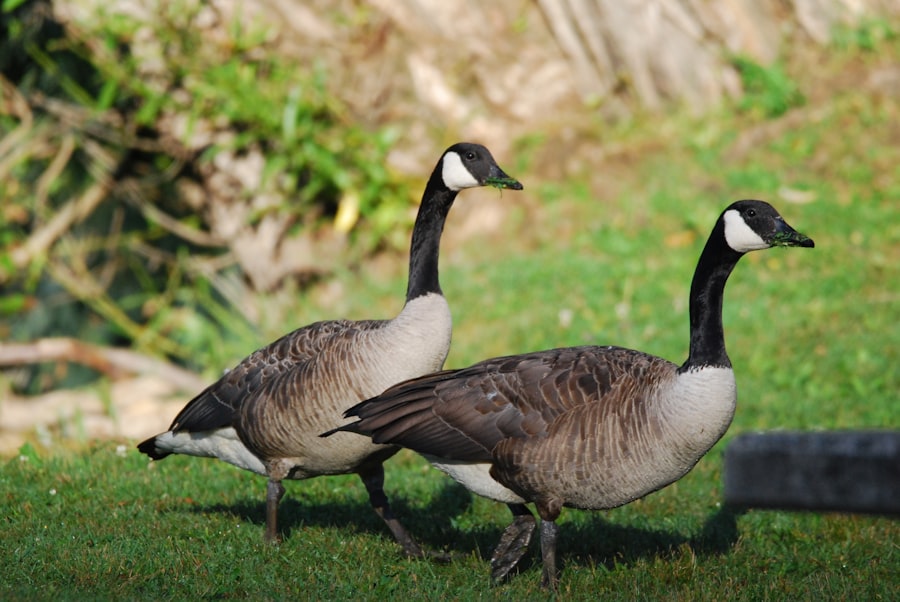
Another method of deterring Canada geese from your lawn is to use repellents. There are several types of repellents available, including chemical repellents and natural repellents.
Chemical repellents often contain ingredients such as methyl anthranilate, which is a non-toxic substance that irritates the geese’s senses and discourages them from landing on your lawn. These repellents can be sprayed directly onto the grass or applied to specific areas where the geese are known to congregate.
Natural repellents can also be effective in deterring Canada geese. These repellents often use ingredients such as garlic or hot pepper to create an unpleasant taste or smell for the geese. They can be applied directly to the grass or used in combination with other deterrent methods.
When applying repellents, it is important to follow the instructions carefully and use them in a safe and responsible manner. Avoid applying repellents near water sources or areas where children or pets may come into contact with them.
Installing bird netting to protect your lawn
Bird netting can be an effective way to protect your lawn from Canada geese. This netting is made from lightweight and durable materials that create a physical barrier between the geese and your lawn.
Bird netting can be installed over the entire lawn or specific areas where the geese are known to congregate. It should be securely fastened to prevent the geese from getting underneath it.
There are several types of bird netting available, including nylon netting and polypropylene netting. Nylon netting is lightweight and easy to install, but it may not be as durable as polypropylene netting. Polypropylene netting is more durable and can withstand harsh weather conditions, but it may be more difficult to install.
Creating a landscape that is unattractive to Canada geese
One long-term solution to deterring Canada geese from your lawn is to create a landscape that is unappealing to them. This can be done by making changes to the layout and design of your lawn.
One way to make your lawn less attractive to geese is to plant tall grasses or shrubs around the perimeter. These plants can act as a natural barrier and make it more difficult for the geese to access the lawn.
Additionally, consider planting native plants that are less appealing to geese. Native plants often have a stronger scent or taste that can deter the geese from feeding on them.
Regularly mow your lawn to keep the grass short and remove any weeds or other vegetation that may attract the geese. Consider using organic fertilizers and pesticides that are safe for the environment and do not attract geese.
Using sound and light to scare Canada geese away
Sound and light can be effective deterrents for Canada geese. These methods work by creating a sense of danger or discomfort for the geese, causing them to avoid the area.
There are several devices available that emit loud noises or flashing lights to scare away geese. These devices can be placed around the perimeter of your lawn or in areas where the geese are known to congregate.
It is important to use these methods safely and responsibly. Avoid using devices that emit loud noises or bright lights near residential areas or areas where they may disturb wildlife or pets.
Developing a maintenance plan to keep Canada geese off your lawn
Regular maintenance is essential to keep Canada geese off your lawn. This includes regularly checking and repairing physical barriers, moving decoys, and reapplying repellents.
Additionally, regularly monitor your lawn for signs of geese activity, such as droppings or grazed grass. If you notice any signs, take immediate action to deter the geese and prevent further damage.
Consider developing a maintenance plan that works for your lawn. This may include scheduling regular inspections and maintenance tasks, such as mowing the grass, applying repellents, and moving decoys.
Seeking professional help to manage Canada geese infestations
In some cases, it may be necessary to seek professional help to manage Canada geese infestations. Professional wildlife management companies have the knowledge and experience to effectively deter geese and prevent further damage to your lawn.
When seeking professional help, it is important to find a reputable company that specializes in wildlife management. Ask for recommendations from friends or neighbors who have dealt with similar issues, and research different companies online to find one that has positive reviews and a good track record.
In conclusion, deterring Canada geese from your lawn requires a combination of methods and regular maintenance. By understanding the behavior of Canada geese and implementing physical barriers, using decoys, applying repellents, installing bird netting, creating an unattractive landscape, using sound and light deterrents, developing a maintenance plan, and seeking professional help when necessary, you can effectively keep Canada geese off your lawn. Take action today to protect your lawn from these pesky birds and enjoy a beautiful and goose-free outdoor space.
If you’re looking for ways to keep Canada geese off your lawn, you might also be interested in learning about how to feed ducks properly. Poultry Wizard has a helpful article on what you should feed ducks to ensure their health and well-being. By understanding their dietary needs, you can attract ducks to alternative areas and deter geese from invading your property. Check out the article here for more information.
FAQs
What are Canada geese?
Canada geese are large water birds that are native to North America. They are known for their distinctive black heads and necks, white cheeks, and brown bodies.
Why do Canada geese come onto lawns?
Canada geese are attracted to lawns because they provide a source of food and water. They like to graze on grass and other vegetation, and they also like to drink from ponds and other bodies of water.
What problems can Canada geese cause on lawns?
Canada geese can cause a number of problems on lawns, including damage to grass and other vegetation, accumulation of droppings, and aggressive behavior towards humans and pets.
How can I keep Canada geese off my lawn?
There are several strategies you can use to keep Canada geese off your lawn, including installing physical barriers, using repellents, and modifying the landscape to make it less attractive to geese.
What are some physical barriers I can use to keep Canada geese off my lawn?
Physical barriers that can be effective at keeping Canada geese off your lawn include fences, netting, and scare devices like balloons or flags.
What types of repellents can I use to keep Canada geese off my lawn?
Repellents that can be effective at keeping Canada geese off your lawn include visual repellents like reflective tape or predator decoys, as well as auditory repellents like noise-making devices.
What are some landscape modifications I can make to keep Canada geese off my lawn?
Landscape modifications that can be effective at keeping Canada geese off your lawn include removing sources of food and water, planting unattractive vegetation, and creating barriers like ditches or berms.
Meet Walter, the feathered-friend fanatic of Florida! Nestled in the sunshine state, Walter struts through life with his feathered companions, clucking his way to happiness. With a coop that’s fancier than a five-star hotel, he’s the Don Juan of the chicken world. When he’s not teaching his hens to do the cha-cha, you’ll find him in a heated debate with his prized rooster, Sir Clucks-a-Lot. Walter’s poultry passion is no yolk; he’s the sunny-side-up guy you never knew you needed in your flock of friends!

